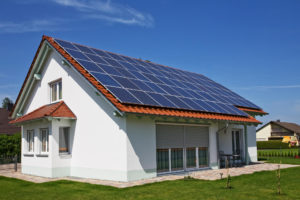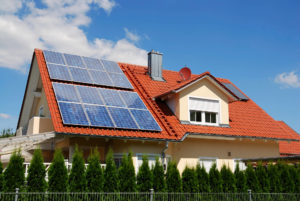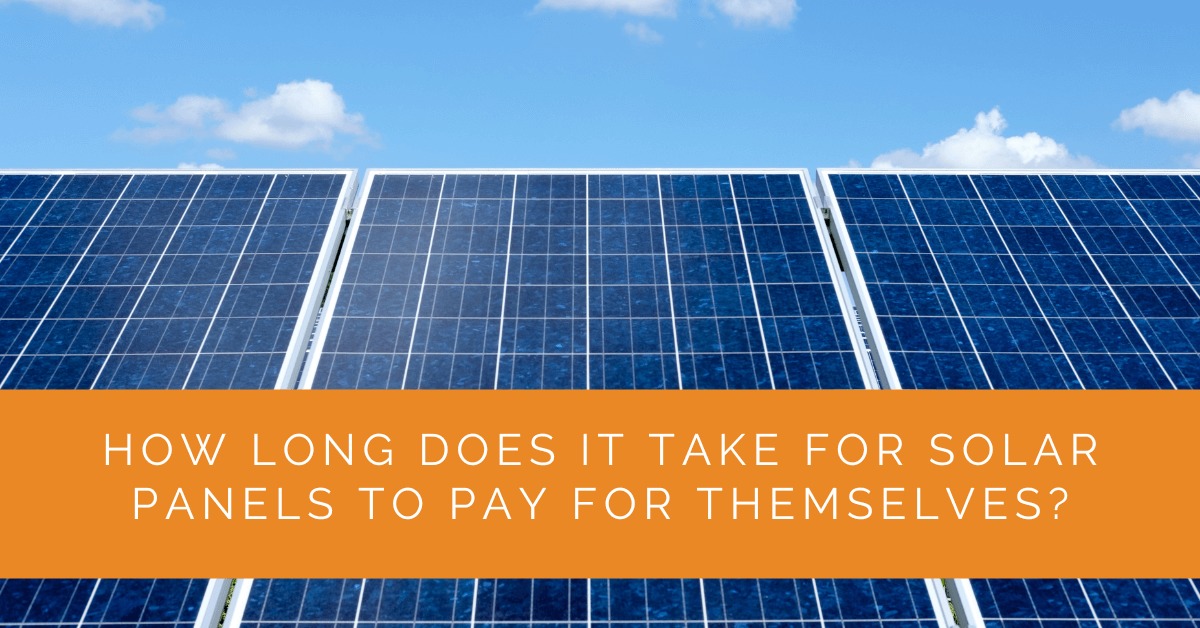As interest in solar energy continues to grow, many homeowners and businesses are considering the installation of solar panels. Beyond the environmental benefits, one of the key factors driving this interest is the potential financial savings and return on investment. In this comprehensive guide, we will delve into the solar panel payback period concept, exploring the factors that influence it and providing insights into how long it takes for solar panels to pay for themselves.
Contents
- 1 Key Takeaways
- 2 Understanding Solar Panel Payback Period
- 3 Calculating the Solar Panel Payback Period
- 4 Regional Variations in Solar Panel Payback Periods
- 5 Factors Affecting Payback Period Reduction
- 6 Other Considerations for Solar Panel Investments
- 7 Case Study: Achieving a Shorter Payback Period for Solar Panel Investments
- 8 Expert Insights From Our Solar Panel Installers About Solar Panel Payback Periods
- 9 Experience Solar Excellence with Us!
- 10 Conclusion
Key Takeaways
- The payback period for solar panels varies based on upfront installation costs, energy production, local electricity rates, and available incentives. Real-world examples highlight that it typically takes around 11 years to recoup the initial investment and enter a period of net savings.
- Factors like abundant sunlight availability and higher electricity rates in a region contribute to shorter payback periods, while regions with lower sunlight and electricity rates may experience longer payback periods.
- Technological advancements, decreasing installation costs, government incentives, and innovative financing options all play a role in reducing the payback period, making solar panels an increasingly attractive and financially viable investment.
Understanding Solar Panel Payback Period
To understand the solar panel payback period comprehensively, it’s essential to delve deeper into the concept and explore the factors contributing to its calculation. The payback period is required for the accumulated savings on your electricity bill to offset the initial cost of installing a solar panel system. Several key factors come into play when assessing the payback period. First, there are upfront installation costs, encompassing the expenses associated with the solar panel system components, including the panels, inverters, mounting equipment, and electrical wiring. Additionally, costs such as installation labor, permits, and inspections should be considered.
Another critical factor in determining the payback period is the energy production and savings generated by the solar panel system. This aspect relies on various factors, such as the system’s capacity, the amount of sunlight available in your location, the angle and orientation of the panels, and any shading or obstructions that may affect their efficiency. Historical weather data and local climate conditions should be considered to estimate energy production and savings accurately. You can calculate the potential savings on your monthly electricity bill by analyzing your current electricity consumption and evaluating the system’s expected energy output. It’s crucial to consider the current electricity rates and multiply the estimated percentage of electricity needs the solar panel system fulfills to obtain projected monthly savings. Through these calculations, the payback period can be determined by dividing the total upfront cost of the solar panel system by the monthly savings obtained from generating your electricity.
Calculating the Solar Panel Payback Period
Calculating the solar panel payback period requires a comprehensive analysis of various cost and savings components. Let’s break down the calculation process into specific steps:
- Gather upfront costs: Begin by compiling a detailed list of all the expenses associated with installing the solar panel system. This includes the cost of solar panels, inverters, racking and mounting equipment, wiring, and any necessary installation labor. Additionally, consider permit fees, inspection costs, and other administrative expenses.
- Assess potential energy production: Evaluate the system’s kilowatts (kW) or kilowatt-hours (kWh) capacity. This information can usually be obtained from the solar panel manufacturer or installer. Consider factors such as the panel’s efficiency, the number of panels in the system, and the expected average daily sunlight hours in your region.
- Estimate electricity bill savings: Analyze your historical electricity consumption data to determine your average monthly kilowatt-hour usage. Multiply this by the current electricity rate to calculate your monthly electricity bill. Next, estimate the percentage of your electricity needs the solar panel system can fulfill based on its expected energy production. To calculate your projected monthly savings, multiply this percentage by your monthly electricity bill.
- Calculate the payback period: Divide the total upfront cost of the solar panel system by the monthly savings obtained from generating your electricity. The result will give you the months required to recoup your initial investment. To convert this into years, divide the obtained value by 12.
It’s important to note that the payback period is an estimate and can be influenced by system performance, changes in electricity rates, and maintenance costs. However, by following this calculation process, you can gain a reasonable understanding of the timeframe required for your solar panels to pay for themselves.

Regional Variations in Solar Panel Payback Periods
The solar panel payback period can vary significantly based on your geographical location. One of the primary factors influencing the duration it takes for solar panels to pay for themselves is the availability of sunlight. Regions with abundant sunlight and higher solar irradiation levels tend to experience shorter payback periods. These areas, typically located closer to the equator, receive more sunlight throughout the year, resulting in higher energy production from solar panels. As a result, homeowners and businesses in these regions can generate more electricity and experience quicker savings on their electricity bills, leading to shorter payback periods.
Another significant factor contributing to regional variations is your area’s electricity cost. Regions with higher electricity rates often experience shorter payback periods since the savings from solar energy offset the higher expenses more quickly. Conversely, areas with lower electricity rates may have longer payback periods, as the savings on electricity bills are relatively smaller compared to the initial investment. When assessing the payback period specific to your region, it is recommended to consult with a professional solar installer or utilize online solar calculators that take into account regional factors such as sunlight availability, electricity rates, and incentives unique to your area. These tools can provide a more accurate estimation of the payback period based on your location, enabling you to decide on your solar panel investment.
Factors Affecting Payback Period Reduction
Several factors contribute to reducing the solar panel payback period, making solar panels an increasingly attractive and financially viable investment. Let’s explore these factors in greater detail:
- Technological Advancements in Solar Panels: The continual evolution of solar panel technology has significantly improved their efficiency and energy production capabilities. Modern solar panels can convert a higher percentage of sunlight into electricity, resulting in greater energy generation and faster savings accumulation. By harnessing the power of advanced solar panel technology, homeowners and businesses can experience shorter payback periods.
- Decreasing Installation Costs: Over the years, installing solar panels has significantly decreased. Factors such as increased competition among solar installers, streamlined installation processes, and economies of scale have reduced installation expenses. As the upfront costs decrease, the payback period shortens, making solar panel installations more financially attractive for a wider range of individuals and organizations.
- Government Incentives and Tax Credits: Many governments, at both the federal and state levels, offer various incentives and solar tax credits to promote the adoption of solar energy. These incentives can significantly reduce the upfront costs of installing solar panels and contribute to shorter payback periods. Such incentives include federal investment tax credits (ITC), state-level solar rebates, grants, and loan programs. Taking advantage of these incentives can greatly enhance the financial feasibility of going solar and expedite the payback period.
- Innovative Financing Options: The availability of innovative financing options has made solar panel installations more accessible to a broader audience. Solar leases, power purchase agreements (PPAs), and solar loans allow homeowners and businesses to install solar panels with minimal upfront costs. These financing options distribute the initial investment over an extended period, making achieving a positive cash flow from day one and shortening the payback period easier.
- Increased Energy Consumption and Demand: As energy consumption continues to rise, driven by population growth and increasing electricity needs, generating your electricity through solar panels becomes even more significant. By offsetting a substantial portion of your electricity consumption, solar panels can save your electricity bills substantially. The higher the energy consumption and demand in your area, the quicker your solar panels can pay for themselves.
- System Performance and Maintenance: Ensuring optimal system performance and regular maintenance of your solar panel system is crucial to maximizing energy production and minimizing potential downtime. Proper cleaning, monitoring, and maintenance can help maintain the efficiency and longevity of the panels, ultimately contributing to faster savings accumulation and a shorter payback period.
By taking advantage of these factors, homeowners and businesses can experience a significant reduction in the solar panel payback period. It is essential to evaluate these factors in conjunction with the specific circumstances of your location and financial situation to make an informed decision regarding your solar panel investment.

Other Considerations for Solar Panel Investments
While the financial aspects of solar panel investments are crucial, several other factors warrant consideration before deciding. These factors include:
- Environmental Benefits: Solar panels offer financial advantages and contribute to environmental sustainability. By generating clean and renewable energy, solar panels reduce reliance on fossil fuels and help combat climate change. Installing solar panels demonstrates a commitment to reducing carbon emissions and preserving the environment for future generations.
- System Durability and Lifespan: It is essential to assess the durability and expected lifespan of the solar panel system. High-quality panels with reliable warranties ensure long-term performance and minimize the need for costly repairs or replacements. Understanding the system’s expected lifespan allows you to project long-term financial benefits and plan for potential maintenance or upgrade costs.
- Maintenance Requirements: Solar panels generally require minimal maintenance. Regularly cleaning the panels to remove dirt, debris, and any shading obstructions can help maximize energy production. Additionally, monitoring the system’s performance and promptly addressing any issues or malfunctions ensures optimal efficiency. Understanding the maintenance requirements of your solar panel system allows you to factor in any associated costs and ensure long-term performance.
- Warranty Coverage: When investing in solar panels, it is crucial to carefully review the warranty coverage provided by the manufacturer and the installation company. A comprehensive warranty should cover the panels and other components, such as inverters and racking systems. Understanding the warranty terms and conditions ensures that you have recourse in the event of any unexpected issues or failures.
- Property Value: Installing solar panels can potentially increase the value of your property. Many homebuyers value energy-efficient features and recognize the long-term savings of solar energy. Studies have shown that homes with solar panels sell at a premium compared to those without solar installations. The increased property value adds another financial benefit to your investment in solar panels.
By considering these additional factors, you can comprehensively assess the overall benefits and potential returns on your solar panel investment. While the financial advantages are significant, the environmental benefits, system durability, maintenance requirements, warranty coverage, and potential property value increase contribute to the overall value proposition of going solar.
Case Study: Achieving a Shorter Payback Period for Solar Panel Investments
Background
At Solar Panels Network USA, we recently assisted a residential homeowner in optimizing their solar panel system to achieve a shorter payback period. The goal was to maximize financial savings and ensure the system quickly paid for itself, thereby enhancing the homeowner’s return on investment.
Project Overview
The project began with a thorough analysis of the homeowner’s energy consumption, current electricity rates, and available sunlight. We aimed to provide a comprehensive plan that would leverage technological advancements, government incentives, and optimal system performance to reduce the payback period significantly.
Implementation
Assessing Upfront Costs
We compiled a detailed list of all expenses associated with the solar panel installation. This included the cost of solar panels, inverters, mounting equipment, wiring, and installation labor. By analyzing these upfront costs, we provided a clear picture of the total investment required.
Evaluating Energy Production
We evaluated the system’s capacity, considering the efficiency of the solar panels and the average daily sunlight hours in the homeowner’s region. This assessment helped estimate the potential energy production and savings on the electricity bill.
Estimating Monthly Savings
By analyzing the homeowner’s historical electricity consumption and the current electricity rates, we calculated the projected monthly savings. This involved estimating the percentage of electricity needs that the solar panel system could fulfill and multiplying it by the monthly electricity bill.
Calculating the Payback Period
We divided the total upfront cost by the monthly savings to determine the payback period. This calculation provided an estimate of how many months it would take for the homeowner to recoup their initial investment.
Results
The optimized solar panel system resulted in a significantly shorter payback period. Initially estimated at around 11 years, the various optimizations and incentives reduced the payback period to approximately 8 years. The homeowner started seeing substantial savings on their electricity bills, and with the system’s long lifespan, they could look forward to many years of net savings.
Summary
This case study highlights the importance of comprehensive planning and optimization in achieving a shorter payback period for solar panel investments. By carefully evaluating upfront costs, potential energy production, and monthly savings, Solar Panels Network USA helped the homeowner maximize their return on investment. The optimized system not only paid for itself faster but also provided long-term financial and environmental benefits.
Expert Insights From Our Solar Panel Installers About Solar Panel Payback Periods
Understanding the payback period for solar panels is crucial for making an informed investment. Factors like installation costs, energy production, and local electricity rates all play a significant role in determining how quickly you can recoup your investment.
Senior Solar Installer
Technological advancements and decreasing installation costs have significantly shortened the payback period for solar panels. With the right incentives and financing options, homeowners can start seeing returns much sooner than before.
Lead Solar Technician
Monitoring system performance and regular maintenance are key to ensuring that your solar panels operate efficiently, which directly impacts the payback period. Proper care can lead to faster financial returns and long-term savings.
Solar Installation Specialist
Experience Solar Excellence with Us!
Trust in Solar Panels Network USA, where our seasoned experts deliver top-quality solar solutions for homes and businesses nationwide. With a legacy of countless successful installations and a commitment to sustainable energy, we’re your reliable partner in the solar journey. Ready for a brighter, eco-friendly future? Call us now at (855) 427-0058 and harness the power of the sun!
Conclusion
Understanding the solar panel payback period is essential when considering the installation of solar panels. Individuals can make informed decisions about going solar by evaluating the factors influencing this duration, calculating the costs and savings, and exploring real-world examples. Despite regional variations and initial costs, the financial advantages and environmental benefits make solar panels an increasingly attractive investment. Embrace the power of solar energy and embrace a sustainable future while reaping the financial rewards.
About the Author
Solar Panels Network USA stands at the forefront of solar energy solutions, driven by a team of seasoned solar engineers and energy consultants. With over decades of experience in delivering high-quality solar installations and maintenance, we are committed to promoting sustainable energy through customer-centric, tailored solutions. Our articles reflect this commitment, crafted collaboratively by experts to provide accurate, up-to-date insights into solar technology, ensuring our readers are well-informed and empowered in their solar energy decisions.

